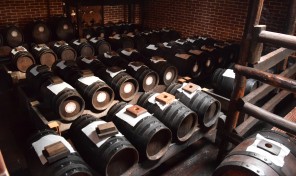How "Aceto Balsamico Tradizionale" Is Made

The production of authentic balsamic vinegar resembles that of wine making. It is made from the unfermented juice of local grapes, traditionally, the white Trebbiano, although other varietals including the red Lambrusco are allowed too.
The grapes are left on the vine for as long as possible, prior to crushing, to “snatch from nature its very last sunbeam”. The resultant must is then cooked down in open pots over a direct flame and simmered for 24 to 30 hours, until it becomes an intensely sweet concentrate and reduced in volume by at least one-half. The must, known as mosto cotto, is then cooled and stored in barrels for six months to allow the sediment to settle before being transferred to a batteria ( a set of progressively smaller wooden barrels). The batterias are stored in vinegar attics, called acetaie, normally on the top floor of the house, to ferment, evaporate, and age over a minimum of 12 years until it becomes a complex, aromatic, intensely sweet, syrupy condiment.
There is no set number of barrels required for a batteria, but a minimum of three are needed for the mosto cotto to undergo the processes that give balsamic vinegar its complex character – Balsamic Vinegar Online Olive Oiltransformation, maturation and ageing. The barrels, which range in capacity from 100 to 10 litres, are made from oak, mulberry, cherry, chestnut ash and juniper. Each barrel imparts flavour and colour to the must, resulting in a vinegar with a multilayered character. All barrels are highly porous and have large square bungholes covered by a cotton cloth to allow maximum exposure to air and assist in evaporation.
Balsamic vinegar goes through two steps of transformation: alcoholic fermentation and acetic oxidation. Fermentation takes place when the must is added to the barrels, along with either an acetobacter, called the mother, or a small amount of strong wine vinegar. Yeasts, either introduced or allowed to develop spontaneously, convert the natural sugars found in the must into alcohol, which is in turn consumed by the acetobacters and converted into vinegar.
Over the years, the vinegar is transferred into smaller and smaller barrels, the water in it evaporates and the vinegar mellows, becoming viscous, intensely aromatic and sweet.
Traditionally, this process is begun in late summer, when the heat encourages a greater rate of bacterial activity. The vinegar is then transferred to the batteria where the barrels are filled to about 70% capacity (leaving space for further acetic oxidisation to occur). Over the course of a year, 15% to 30% of the volume is lost through evaporation. Every year, each barrel is topped off from the next larger one, and the very largest is replenished with new cooked must. This topping up (rincalzo) is typically completed during the winter, when because of the cold weather, bacterial activity is low. Unlike with wine, extreme fluctuations in temperature actually benefit balsamic vinegar making, helping it achieve its density and complex character. Modena and Reggio, with their hot summer evenings and cool winter nights, have an ideal climate for vinegar attics.
Over the years, the vinegar is transferred into smaller and smaller barrels, the water in it evaporates and the vinegar mellows, becoming viscous, intensely aromatic and sweet. The vinegar’s final balance is achieved through a series of corrections made periodically to adjust the sugar or acidity level, a task that requires a great deal of skill and expertise on the part of the vinegar maker. At least 12 years of ageing must take place before the vinegar can be considered for approval and sold as aceto balsamico tradizionale. Another 13 years of ageing (25 years in total) must be completed before the vinegar can be approved and sold as tradizionale extra vecchio. A better understanding of the high prices these wonderful creations command can be gleaned from the fact that it takes fully 100kg of grapes to initially make 25 litres of cooked must, which after 25 years of expert maturing will have become just 1.5 litres of extra vecchio, or in other words, just 15 bottles of 100ml vinegar!
So, not just the cost of lots of raw material, the incredible expertise applied along the way and the vast expanse of time but also the monumental cost of storing the maturing vinegar for so long without any financial return whatsoever until eventually bottled and sold, should be taken into account when evaluating the cost of a traditionally matured balsamic.



